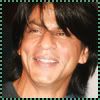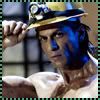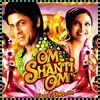
n November 2003 I picked up a program for Australia’s first Indian Film Festival and was astonished to find that every second film described in the booklet starred Shah Rukh Khan.
My nephew and I joked about the prospect of there being only one actor in India. At that stage I didn’t know that the demand for films in India exceeds the number of stars available.
I didn’t know that Khan, one of India’s biggest stars - was affiliated with Yashraj Productions who had linked up with a local distributor. I also had no idea how much I would enjoy Bollywood cinema. At the time I needed something uplifting so I chose to see Dil ToPagal Hai because it was described as being a light film with “great song and dance numbers and a good looking cast”. I recognized Khan immediately as the actor who advertised shampoo on Indonesian TV. Dil To Pagal Hai was only the second Bollywood film I had seen; the first had been Raja Hindustani which I’d watched on TV. Both films left me with the same impression - that of insignificant story-lines but top-notch acting. I remember thinking that Khan was an odd choice for a romantic lead because Akshay Kumar was more conventionally good-looking but as the film progressed I became caught up in Khan’s performance and his appearance became strangely beguiling.
Since that first festival I have watched many Bollywood films, passing my favourite DVDs on to a friend who has watched them with her 13 year old son. After a while I saw a pattern emerging – her son would ask if the DVDs I’d bring had Shah Rukh Khan in them. They were obviously his favourites. When asked why he thought Khan was a good actor Arthur thought for a bit then said “he plays diverse characters like the hero, the bad guy, the stupid guy…” The last type mentioned probably refers to Khan’s portrayal of naïve characters such as Babloo (Duplicate) and Vijay (Don).
I’d have to agree though, Khan is a versatile actor with an impressive range. From slapstick to tragedy, from commercial films to arthouse ventures; from the mannered to the more natural and understated, he has crossed genres, styles and garnered a large fan-base from beyond the diaspora.
In her book King of Bollywood: Shah Rukh Khan and the Seductive World of Indian Cinema, film critic Anupama Chopra includes a comment made by Ashutosh Gowariker about Khan’s early approach to acting - “If there was an emotion given to him he would multiply it twenty times.” The skill of overacting is often denigrated and considered to be cheesy or rather low-brow. Yet not all actors can overact well. To express the operatic highs and lows – the emotional excesses of masala films and melodramas is an underrated art. Large displays of emotion and gesture whether in villainous or heroic mode, sit comfortably within Khan’s repertoire. So comfortably that he was able to draw public sympathy for his portrayal of a villain in Baazigar (1993). As Chopra puts it “even as Shah Rukh slaughtered innocents, the audience was firmly on his side. As he murdered, they clapped.” A similar show of public support occurred for his portrayal of a self-mutilating stalker in Darr (1993).
Tears, blood, anguish, bravado and running – lots of running, were common features of his earlier films among them – Deewana (1992), Karan-Arjun (1995), Chaahat (1996) and Koyla (1997). Apart from acting in these unsophisticated melodramas, there were also "clown-roles" where Khan amplified his characters to create cartoon-like caricatures in films like Chatmatkar (1992), Oh Darling Yeh Hai India (1995) and Duplicate (1998).
An emphasis on external show was almost a prerequisite for the types of commercial films Khan was doing earlier in his career. A good actor accommodates himself to the director’s vision of the film. Director Shimit Amin (Chak De!) has recently likened working with Khan to “driving a luxury car” while Gowariker (Swades) has referred to him as an obedient actor.
Quite early in his career – in Kabhi Haan Kabhi Naa (1995), Khan showed that he could play a more complex character responding to situations arising from the story itself rather than being driven by stereotype.
However these were not the films the Indian public was choosing to see. The failure of Dil Se (1998) at the box-office in India testifies to the fact that audiences wanted escapist fare. And so the directors of these popular but none-too-subtle extravaganzas set the boundaries for many of Khan’s early performances.
Anupama Chopra makes many illuminating connections between Khan’s work and social and economic changes taking place in India in the 90s. Rapid modernization, a growing middle class and an urban focus made Bollywood reconsider the types of images it was projecting and a more “youthful” cinema was born. Aditya Chopra and Karan Johar were in their 20s when they directed the films that made Khan a superstar. The Raj-Rahul roles which have defined him have also created interest in Bollywood across the globe.
In Australia - Bollywood has three faces. There’s Aamir Khan in Lagaan – a popular film with cricketers and filmbuffs. Aishwarya Rai is recognised for Bride and Prejudice which many Australians erroneously believe to be a Bollywood film.
And there’s Shah Rukh Khan as Raj-Rahul or Devdas because he is the Bollywood actor that we most often see on our TV and cinema screens.
Khan’s roles in the Yashraj and Dharma romantic melodramas play out like one extended performance. Although Khan is a successful, well adjusted yuppy in all of them, the films themselves are more relationship focussed than a lot of his earlier work so that interactions between characters appear more complex and natural.
I refer to scenes like the one in Dilwale Dulhania Le Jayenge (1996) when Raj questions Simran about her views on marriage crossing the line between comfortable curiosity and vested interest as he presses her to admit that her arranged marriage could be a loveless misery.
Or the scene in Kuch Kuch Hota Hai (1998) when Rahul and Anjali are reunited years after a rift in their adolescent friendship.The emotional complexity of that reunion is beautifully communicated by Khan and Kajol as the characters move from awkwardness to familiarity; from shyness to an awareness of deeper feelings within a matter of minutes! In these scenes there are some challenging transitions which could have collapsed in lesser hands.
Khan is older and times are changing. It’s not so much that he has grown as an actor but more to do with audiences seeing different facets of his talent as bought out in the current wave of issues films. The sorts of roles that are being written for him now seem to be moulding him into a champion of good causes – Indo-Pak relations, women’s issues and patriotism to mention a few.
His acting style has changed in keeping with the more naturalistic feel of these films. It was not surprising that Khan could channel a sustained sense of despair in the operatic tragedies of Asoka (2001) and Devdas (2002).
Earlier films such as Dil Se and Mohabbatein clearly demonstrated that he could project a deep sense of melancholy. The real surprises have come more recently in Swades (2004) and Chak de India (2007) - in Khan’s restrained portrayals of men who feel deeply but are more guarded in the way they express themselves. Swades is the story of an NRI who comes home. In it there is a wonderful progression of scenes that shows Khan internalizing the character’s feelings. It begins with the playful dhoti tying scene where his lighter comedic talents are fully utilized in a suggestive manner – with inflections and slight changes in body language. This is followed by at scene which centres upon a panchayat meeting where the village elders quiz Mohan (Khan) about life in America. He begins in an articulate controlled way then slowly loses it as he recalls suffering witnessed in the darkness of a farmer’s hut. A subtle personal journey takes place and a refined performance makes it possible.
Anupama Chopra quotes Khan as saying "There is not going to be some new revelation, another layer when this layer is over." When asked whether she believed Khan’s statement Chopra said “No, Chak De just proves that it’s not true. Shah Rukh’s always been very self-deprecating and the first one to say “I have only 5 expressions” and that kind of thing…I think there is a lot more to come.”
From where I sit in "far flung" Australia – I hope this is true.
PlanetBollywood
 Can you be hot at 40?
Can you be hot at 40?

 "Shah Rukh is promoting Om Shanti Om in a big way — so why not? After all, he is the producer of the film.
"Shah Rukh is promoting Om Shanti Om in a big way — so why not? After all, he is the producer of the film.






















